Unveiling of the DEWAR Monument
Kennedy Cemetery
Beckwith Twp, Lanark Co, Ontario
August 15, 2010
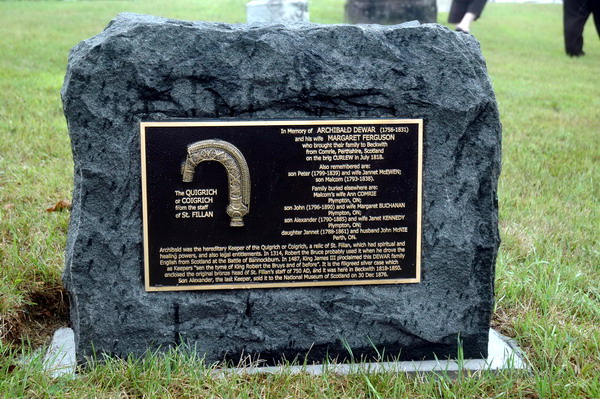
Home | Intro | Quigrich | Tree | Library | Plaque
Unveiling of the DEWAR Monument  |
| 15:00 | Participants meet at Cemetery gate | |
| 15:05 | Procession to Site of the Monument Led by the Piper (Plaque covered by McNab tartan) | |
| 15:10 | Welcome – Jim Kirkpatrick as Master of Ceremonies | |
| 15:15 | Introductory Remarks, and the Story of the Quigrich – Malcolm Dewar | |
| 15:30 | Remarks from Invited Guests – Richard Kidd – Marilyn Sneddon | |
| 15:40 | Unveiling – Malcolm Dewar and all family members present | |
| 15:45 | Ecumenical Prayers –
Jim Kirkpatrick – Dedication of the Monument – Thanksgiving and Remembrance | |
| 15:50 | Lament – “Flowers of the Forest” Played by the Piper | |
| 15:55 | Closing Remarks –
Jim Kirkpatrick | |
| 16:00 | Adjourn |
|
In Memory of ARCHIBALD DEWAR 1756-1831 Also remembered are: Family buried elsewhere are: Archibald was the hereditary Keeper of the Quigrich or Coigrich, a relic of St. Fillan, which had spiritual and healing powers, and also legal entitlements. In 1314, Robert the Bruce probably used it when he drove the English from Scotland at the Battle of Bannockburn. In 1487, King James III proclaimed this DEWAR family as Keepers “sen the tyme of King Robert the Bruys and of before”. It is the filigreed silver case which enclosed the original bronze head of St. Fillan’s staff of 750 AD, and it was here in Beckwith 1818-1850. Son Alexander, the last Keeper, sold it to the National Museum of Scotland on 30 Dec 1876. |
EMC Events - The Beckwith Township motto states it is "Proud of our Past". On Aug. 15, part of its past will be extended back to 750 AD. A ceremony to unveil a plaque which encapsulates part of its history will take place this Sunday, at 3 p.m. in the Kennedy Cemetery at the intersection of Glenashton Road and the Dewar Side Road a few kilometres south east of Carleton Place. The public is invited to come and be a part of Beckwith history.
The history which will be commemorated on the plaque began with the Dewars, St. Fillan and the Quigrich.
St. Fillan left Ireland about 750 AD to bring Christianity to the Celts of the western highlands of Scotland. He settled in Strathfillan, a long valley, which drains into the west end of Loch Tay at Killin in Perthshire. The Crozier or head of his staff was in the shape of a shepherd's crook, 6"X9" and made of bronze with silver filigree. Later the filigree was incorporated into an elaborate silver outer case called the Quigrich.
When St. Fillan died the Quigrich was entrusted to the Jore family, which in various documents is also spelled Deore or Deior or Doir and finally Dewar. This staff head was believed to have mystical powers which could cure many ailments affecting both man and beast. When dipped into a container of water the liquid was believed to be able to cure both physical and mental problems. This belief was so widely held that repeated legal attempts were made over a 500 year period by various church officials to confiscate the artifact to increase their own power. None were successful.
The most significant decision was a proclamation by King James III in 1487 that the Deoir family had been the keeper of the Quigrich "sen the tyme of King Robert the Bruys, and of before" and that all must recognize their legitimacy. This was restated in a writ in 1744. Bruce's reign began in 1306 and he may have used it for inspiration before the Battle of Bannockburn in 1314 when he routed the English army and drove them from Scotland.
The end of the Napoleonic wars in 1815 meant the end of the demand for highland beef and wool for uniforms for the English army and the result was a depression. The English were afraid that Americans might repeat their invasion of 1812-14 into Canada and established an assisted migration plan in 1815 to increase the number of potential troops on the north side of the Great Lakes. Passage was free but a deposit of 10 pounds was required from each settler, which would be returned after two years of suitable improvement on free 100 acre lots. The average farm worker's annual salary in Scotland was 16 pounds so this was a major investment.
On July 21, 1818 the brig Curlew sailed from Greenock, Scotland with the Quigrich and its keeper Archibald Dewar and his wife Margaret, daughter Janet and husband John McNie and two children, son Malcom (one "l") and his wife Ann and two children, son John and son Peter who was baptized Patric. The eldest son Alexander had stayed behind to sell the crops and livestock in the fall and he came the following spring.
There was a report that a young boy in Carillon, Quebec who had whooping cough was touched by the Quigrich as the Dewars worked their way up the Ottawa River on their way to Beckwith and was not only cured but lived to be 95. It should be noted that this family was from the Loch Tay area and probably believed in the power of the relic. Current scientific literature supports the idea that positive thinking can have a positive effect on disease outcome. Maybe it did here.
Archibald settled on Concession 7, Lot 25SW which is now the Cavanagh quarry on Glenashton Road. The Quigrich would have been there until his death in 1831 when it was inherited by his eldest son Alexander on Concession 9, Lot 19SW on the Jock River. It would have been there or in a secure location until Alexander moved to Plympton in Lambton County near Sarnia in 1850.
The second son Malcom, settled on Concession 7, Lot 23SW and the youngest son Peter settled on Concession 7, Lot 25NE beside his father resulting in three Dewars being within sight of each other on what is now Glenashton Road and where the Kennedy Cemetery is located. The third son John settled on Concession 9, Lot 20NE beside his brother Alexander. Janet (Dewar) McNie was the oldest child and settled with her husband John and family near the old municipal office in Bathurst.
When the railroads opened up southwest Ontario, Alexander took the Quigrich and his family to Plympton in Lambton County. Without the belief system of Loch Tay the relic proved ineffectual but its value as an artifact was increasing. Lord Elgin, the Governor General of Canada, offered 300 pounds for it and was turned down. Sir Daniel Wilson had been secretary of the Society of Antiquarians in Scotland, which is now the National Museum of Scotland and had been trying to locate the Quigrich for many years. He was now in Canada as the first president of the University of Toronto. He finally located Alexander and the Quigrich and offered 400 pounds on behalf of the Society. After an extended set of negotiations they reached a complicated agreement. On Dec. 30, 1876 Alexander sold the Quigrich to the Society for 700 pounds but donated 200 pounds toward the purchase.
It was also to be put on permanent display for the enjoyment of all. It is now on display in the National Museum of Scotland and is considered one of their most prized artifacts.
Submitted by Malcolm Dewar.














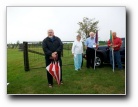


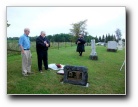
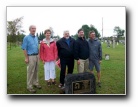
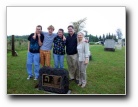
Copyright © 2010 Glen C Bodie